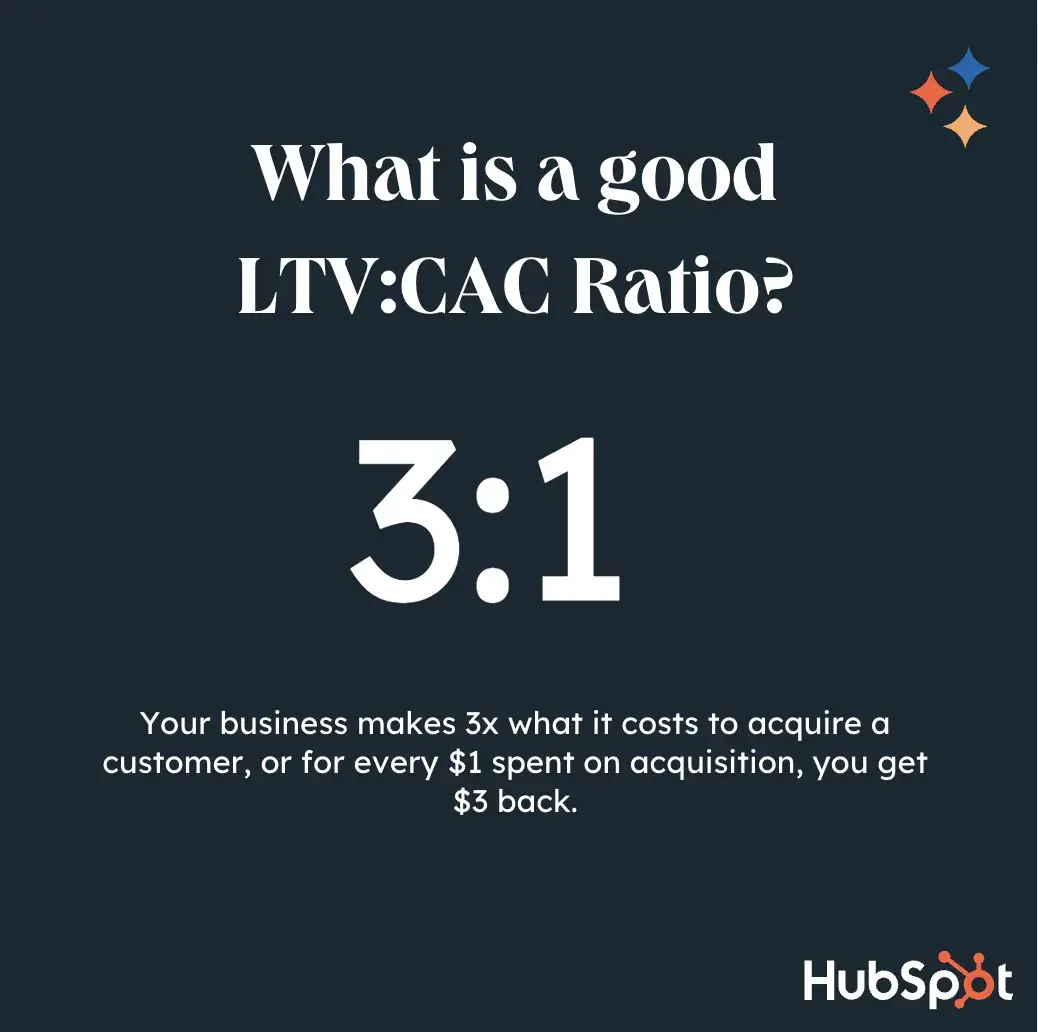This is known as the LTV to CAC ratio. This ratio answers, “Are we making a profit and attracting the right customers?” Let me walk you through the differences between CAC and LTV, how to calculate the LTV:CAC ratio, and how to get the most from this metric for your business.
Table of Contents
Customer Acquisition Cost vs. Lifetime Value
Customer acquisition cost (CAC) is how much your business spends on sales and marketing to attract a new customer.
Lifetime Value (LTV) is the average amount of revenue one single customer generates for the duration of their business with you.
These metrics exist independently, but they also are used as a comparison to help you understand the effectiveness of your acquisition efforts and business profitability.
Successful customer acquisition means attracting buyers who are most likely to do business with you. But when you have these customers, how do you know if your acquisition methods actually turn a profit? Comparing customer acquisition cost against lifetime value is a great way to calculate this.
LTV:CAC Ratio
An LTV:CAC ratio helps you understand your customers’ overall spending with your business based on how much you spend to acquire them.
I find this metric helpful because you’ll see whether you’re outspending on acquisition or missing out on valuable opportunities to gain new customers because you don’t spend enough.
Overall, your ratio tells you if your business is profitable, and companies use this metric to guide spending and find a balance between acquisition and retention that achieves profitability.
How to Calculate LTV to CAC Ratio
To calculate LTV:CAC ratio, divide customer lifetime value by your customer acquisition cost. Not sure how to calculate these?
I’ve got you covered. Here’s a post from a former HubSpot service employee on how to calculate customer lifetime value. And, here’s a post that will teach you how to calculate customer acquisition cost.

The most common way to interpret results is to view it as an X:1 ratio, where X is the result of your equation and 1 represents one dollar spent on acquisition.
So, for example, if your business’s LTV is $1,200 and your CAC is $500, your equation would be
1,200/500 = 2.4
Your LTV, rounded, for this example, would be 2:1, where for every $1 spent on acquisition, you get $2 back.
If your business’s LTV is $600 and your CAC is $200, your equation would be
600/200 = 3
And your business’ LTV:CAC would be 3:1.
Featured Resource: Free LTV:CAC Ratio Calculator
Download for Free
Once you’ve conducted your equation, how do you know if you have a good score?
What Is a Good LTV:CAC Ratio?
Most experts, like Sergey Pirogov, founder and CEO of molfar.io, agree that 3:1 is a good LTV to CAC ratio. You can interpret it as your business makes 3x of what it costs to acquire a customer, or for every $1 spent on acquisition, you get $3 back.

What is a good LTV to CAC ratio for SaaS?
As I’ve established, a good LTV to CAC ratio for businesses, including SaaS businesses, is 3:1 because this ratio indicates that a business is striking a healthy balance between acquiring customers and generating long-term revenue.
If the ratio is significantly lower (e.g., 1:1 or 2:1), it suggests that the cost of acquiring customers is too high relative to their lifetime value, which can lead to unsustainable growth. On the other hand, a ratio higher than 4:1 might indicate that you might not be spending enough on sales and marketing and are missing out on valuable opportunities to attract new customers.
That said, if you’re an early-stage SaaS startup, it’s normal to have a lower LTV to CAC ratio (sometimes closer to 2:1) because you’re likely still fine-tuning your marketing, sales processes, and customer retention strategies. However, as your company scales, you should aim to get to the standard 3:1 ratio or higher.
LTV:CAC Ratio Benchmarks
Although 3:1 is considered the standard when it comes to LTV:CAC ratios, good ratios can vary depending on the industry. I’ll share different industries’ LTV:CAC ratios as calculated and compiled by First Page Sage:
|
Industry |
LTV |
CAC |
LTV:CAC Ratio |
|
Business Consulting |
$2,622 |
$656 |
4:1 |
|
Ecommerce |
$252 |
$84 |
3:1 |
|
Legal Services |
$4,115 |
$915 |
4.5:1 |
|
SaaS (B2C) |
$2,306 |
$166 |
2.5:1 |
|
SaaS (B2B) |
$664 |
$273 |
4:1 |
Remember that every industry operates and grows differently. This means, what’s considered a good LTV:CAC ratio for one industry might not be great for another. I recommend you do your research and compare ratios across your industry to determine ways you can improve your business.
Causes of a Low LTV to CAC Ratio
If you have a low LTV to CAC ratio — typically considered as anything below 3:1 — this signals that you’re spending too much money to acquire customers relative to the revenue those customers generate over their lifetime. This imbalance can lead to cash flow issues and unsustainable growth, especially if you’re a SaaS company or use a subscription-based pricing model.
Here are some possible causes of a low LTV to CAC ratio:
1. High Customer Acquisition Costs
When the cost of acquiring new customers is too high, you might end up with a low LTV to CAC ratio. This is often due to inefficient marketing spend, poorly targeted ads, or a lack of focus on the most profitable customer segments. For example, if you spend excessively on paid ads that target a broad audience, you will incur high acquisition costs but a low conversion rate.
2. High Customer Churn
If customers are leaving your business soon after signing up or making a purchase, you’re experiencing a customer churn. This means you’re currently unable to capture enough value from your customers to justify the acquisition costs.
For example, if I run a SaaS company and customers cancel their subscription after only a few months, this can lower the customer lifetime value, which, in turn, will reduce my LTV:CAC ratio.
3. Underpriced Products or Services
If your product is priced too low, you may be unable to generate sufficient revenue over the customer’s lifecycle, even if your CAC is under control. A good example of this is a SaaS company with a freemium model that fails to convert enough users into paying customers, or charges too little for premium features.
4. Ineffective Onboarding or Product Experience
If your customers don’t fully understand the value of your product or are frustrated during the onboarding process, they may churn early. And if they do, you won’t be able to generate enough revenue to justify your CAC.
5. Poor Customer Support or Service
According to NICE’s Digital-first Customer Experience Report, 95% of customers say that the quality of customer support impacts their brand loyalty. I think it’s counterintuitive to spend a lot of money acquiring customers only to offer them subpar customer support when needed.
Slow or unresponsive customer service can cause dissatisfaction and drive users to look for alternatives, even if they were initially satisfied with your product.

Tips on How to Improve Your LTV to CAC Ratio
If you have a low LTV to CAC ratio, here are some pro tips to help you improve it and use it to measure how sustainable your company is:
1. Monitor your LTV to CAC ratio regularly.
A healthy LTV to CAC ratio (typically between 3:1 and 5:1) indicates that your customers generate more revenue over time than the cost of acquiring them. Keep an eye on this metric over time to ensure that your customer base isn’t only growing but also staying profitable. A lower or declining ratio can be a sign that your growth is unstable, and you need to make immediate adjustments to your business strategy.
For example, if you track your LTV to CAC ratio monthly and notice that it dropped from 3:1 to 2:1, you may decide to pause expensive ad campaigns and focus on retaining existing customers to restore balance.
2. Segment your customer base for deeper insights.
Different customer segments may have varying LTVs. By analyzing your ratio by segment, you can identify which customer groups are more profitable. This way, you can focus your marketing efforts on acquiring high-LTV customers to improve the ratio and ensure long-term sustainability.
A good example of this is the owner of an ecommerce business that finds that repeat customers aged between 25 and 35 have an LTV double that of younger buyers. So, they shift their marketing budget to target this segment more aggressively.
3. Optimize customer retention.
I learned that improving customer retention, which is your ability to keep your customers over time by encouraging repeat purchases or subscription renewals, can significantly boost your LTV. To do this, invest in post-purchase engagement, loyalty programs, and excellent customer service to lengthen customer lifecycles.
For example, you could introduce educational materials like tutorials or webinars to help your new customers understand the value of your product and reduce the likelihood of churn within the first three to six months.
4. Refine marketing spend to lower CAC.
Examine your customer acquisition costs and see if you’re spending more than is necessary or investing in a channel that isn’t yielding results. If you are, I suggest redirecting that portion of the budget toward channels that produce the most cost-effective conversions. This will reduce the CAC and improve the ratio.
Take a direct-to-consumer clothing brand, for example. The brand realizes that paid social ads are expensive and underperforming, so they shift to influencer partnerships, which cuts their CAC by 30% while bringing in their ideal customers.
5. Upsell and cross-sell to boost LTV.
You can increase the value customers bring over time by offering additional products or services. Upselling and cross-selling can drive up the average LTV without additional acquisition costs, which will improve the overall ratio and keep your business on a profitable trajectory.
For instance, if you own an online software company, you could introduce a premium add-on for existing users. If 25% of your customers upgrade, you would’ve raised the overall LTV without incurring customer acquisition costs.
6. Improve customer support.
As you invest money in acquiring customers, I recommend also investing in building a high-quality customer support team that is responsive and addresses customer issues quickly. For instance, you might add a chatbot to your website to handle customers’ frequently asked questions and direct them to your knowledge base.
You can also add live chat support or implement a dedicated account management team for higher-value customers to increase satisfaction and reduce churn.
If you’re looking for an easy way to calculate your metrics, including LTV, CAC, churn, and average ticket time, look no further than our handy customer service metrics calculator.
Crunching the Numbers
The most straightforward understanding of comparing your business’s LTV to CAC is to see if your company is profitable — you don’t want to spend more money than you get back.
When reflecting back on my tutoring days, I can see that my low LTV:CAC ratio was because of high customer churn due to the short-term nature of the tutoring contracts. It took me too much time and effort to get customers who didn’t stick around for long.
If you want to accurately calculate your LTV:CAC ratio, use our template to figure it out and see if there’s room for improvement at your business.
Customer Acquisition
.png?width=112&height=112&name=Image%20Hackathon%20%E2%80%93%20Vertical%20(85).png)
-1.png)
.png)


![7 Customer Acquisition Challenges You Might Face This Year [New Data]](https://53.fs1.hubspotusercontent-na1.net/hubfs/53/customer%20acquisition%20%20(1).webp)







